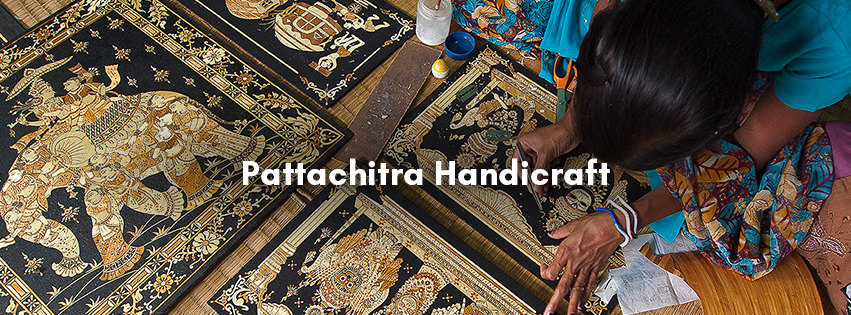With strokes of natural colours beautiful and bright, the faces of Krishna and his many forms come alive in Pattachitra paintings, a traditional art form from Odisha. Its rich history dates back to ancient times.This art form is a Jagannath devotee’s devotion poured onto the canvas in the purest and most ethereal form.
The name “Pattachitra” comes from the Sanskrit words ‘Patta’ meaning canvas and ‘Chitra’ meaning picture. This art form is deeply intertwined with the religious practices and cultural heritage of Odisha. Historically, Pattachitra paintings were used as a means of storytelling, depicting scenes from Hindu mythology, especially the stories of Lord Jagannath, an incarnation of Lord Krishna, whose temple is located in Puri, Odisha. The art form flourished under the patronage of kings and temples, where artisans were commissioned to create intricate paintings for religious festivals and rituals.
Origin
The origin of Pattachitra can be traced to the village of Raghurajpur in Odisha, which remains a vibrant hub for this art form. The tradition is believed to have begun over a thousand years ago, during the reign of the Eastern Ganga dynasty. The Pattachitra painters, known as Chitrakars, initially created these paintings to be used during the Rath Yatra festival when the deities were taken out of the Jagannath Temple and the inner sanctum was decorated with paintings. This practice continues to this day, with each family in Raghurajpur contributing to the creation of these sacred art pieces.
An artisan from the crafts village revealed that when the vaishnava culture started setting its foot in Odisha, and Rath yatra originated, the believers of Shree Jagannatha created several small souvenirs in the form of paintings. These were paintings of the Holy Trinity in several forms, from a ‘bindi’ sized circle, to a large painting encapsulating the blueprint of Puri’s Jagannath Temple. These were colloquially known as ‘Jatri Patti’. They eventually evolved, and were poured on temple walls, and Pattachitra as we know today.
Raghurajpur
From bright hues of pink, to subtle blue; from appealing green to attractive orange, the colours all speak as one walks through the lanes of this popular village in Puri district. Home to over 300 artisans with expertise in several different traditional art forms, this village is a cultural delight where people worship art the same way they worship their god.
Raghurajpur and Danda Sahi are two popular crafts villages in close vicinity to each other where the artists have lived for ages. These artists are the finest in their work and create breathtaking artifacts. Their skills are recognized across the globe, and these artisans truly pull us closer to our roots, our land, and our soil.
About hundred or so houses lined up with beautiful paintings on the walls are self-Explanatory. Raghurajpur is also home to several performing artists like late Guru Kelucharan Mohapatra, well-known for Odissi and Gotipua dance, a form of acrobatic dance precursor to Odissi. There is a dance studio here where young students receive training in Gotipua. A lot of these students have also represented the state on a national platform.
Raghurajpur was recognized as a Heritage village in 2000 and since then, along with the Government of India, institutions like INTACH, ICCI, NORAD and India Foundations for the Arts have been working to develop it as a crafts village. If you visit Raghurajpur, you could also join in for workshops where they teach Pattachita, Palm Leaf etching, Ganjapa card making, and colouring betel nuts, to name a few. The village is also known for delicate brushwork on tussar silk, stone and wood carvings. Intriguing stories are depicted through paintings on coconuts and betel nuts, papier-mache toys, and masks are also major attractions here.
Every house’s front room is an exhibition room, where tourists are invited and briefed about the art form. The warmth shown by the artisans is what draws so many people to the village.
There is an ATM machine in the village and a few artisans also accept payments via PayTM.
Process
Pattachitra flows through the veins of tradition, handed down across generations. Its essence lies in the meticulous process that begins with the creation of its canvas, known as ‘patta’. This canvas, crafted from cotton cloth, undergoes a ritualistic preparation. Pattachitra can never be complete without a balance and coordinated effort of both the genders. It is not simply a work of leisure for the dwellers but an emotional connection to the lord.
What gives Pattachitra an edge over other art forms is the use of natural colours and the ancient method of preparation. They get the white colour from the conch shell, red colour from Hingula stone and yellow from Harikala stone. Preparing the colours takes about a month, while the canvas takes about a week. It begins with mashed palm leaves and cotton cloth. Once they are dried up, a layer of tamarind, turmeric (not always) and white chalk is used to harden the canvas. The conch shell gives it the white shade.
Once prepared, the canvas becomes a sacred ground for storytelling. Using brushes delicately fashioned from the hair of domestic animals, artists bring to life intricate designs and vivid narratives. These stories often revolve around revered figures such as Lord Krishna and Jagannath, rendered in natural colors sourced from minerals, stones, and organic materials. Each pigment, steeped in history, lends its unique hue to the vibrant tapestry of the artwork.
The hallmark of Pattachitra lies not only in its subjects but also in its distinctive style—a marriage of bold lines and brilliant colors that breathe life into the mythological tales portrayed. As the painting nears completion, a final touch of lacquer is applied, not just to preserve the artwork but to bestow upon it a lustrous sheen, a testament to the reverence and craftsmanship embedded within every stroke.
Pattachitra stands not just as an art form, but as a living testament to cultural continuity and artistic mastery—a testament that continues to captivate and inspire across ages.
Present-Day
While the artform has always been an integral part of Odisha’s ritualistic worship of Lord Jagannath, it was Helena Gelly, a woman from London who visited the village 20 years ago, who played a huge role in spreading the word about this art form.
Today, Pattachitra continues to be an integral part of Odisha’s cultural identity. The village of Raghurajpur is a designated heritage crafts village, attracting tourists and art enthusiasts from around the world. The artists have adapted to modern demands while maintaining the traditional techniques and motifs. They create not only traditional paintings but also contemporary art pieces, decorative items, and souvenirs that appeal to a broader audience. Workshops and training programs are conducted to ensure the younger generation learns and preserves this ancient art form.
Modern Work
In recent years, Pattachitra has seen a revival, with artists experimenting with new themes and mediums. In contemporary times, while the core techniques and motifs remain unchanged, Pattachitra has adapted to modern demands. Artists now explore a broader range of themes, incorporating contemporary subjects and styles. This fusion of tradition and modernity has broadened the appeal of Pattachitra, attracting global attention and expanding its market beyond religious contexts attracting collectors and art connoisseurs worldwide. Additionally, Pattachitra motifs are now found in various forms of decorative arts, fashion, and home decor, making the art form more accessible and versatile. Collaborations with designers and brands have further enhanced the visibility and appreciation of this exquisite art form.
Future
The future of Pattachitra looks promising, thanks to the efforts of the artisans, government initiatives, and cultural organizations dedicated to preserving and promoting this heritage. There is a growing recognition of the need to document and archive the techniques and stories associated with Pattachitra to ensure they are not lost to time. Efforts are being made to provide financial support and market access to the artists, enabling them to sustain their livelihoods while continuing their craft. As global interest in sustainable and handmade products increases, Pattachitra is well-positioned to thrive, offering a unique blend of artistic tradition and contemporary relevance.
Pattachitra is not just an art form but a testament to the rich cultural tapestry of Odisha. Its history, origin, and the intricate process of creation reflect a deep connection to the region’s religious and cultural heritage. As it evolves to meet modern tastes and markets, Pattachitra continues to enchant and inspire, promising a vibrant future for this ancient art form.









